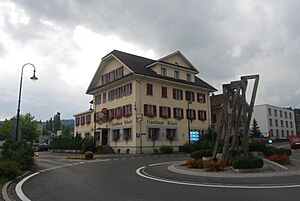Dagmersellen facts for kids
Quick facts for kids
Dagmersellen
|
||
|---|---|---|
|
||
| Country | Switzerland | |
| Canton | Lucerne | |
| District | Willisau | |
| Area | ||
| • Total | 23.87 km2 (9.22 sq mi) | |
| Elevation | 481 m (1,578 ft) | |
| Population
(Dec 2020 )
|
||
| • Total | 5,680 | |
| • Density | 237.96/km2 (616.3/sq mi) | |
| Postal code |
6252
|
|
| Localities | Buchs, Uffikon | |
| Surrounded by | Altishofen, Egolzwil, Knutwil, Mauensee, Nebikon, Reiden, Wauwil, Winikon | |
Dagmersellen is a small town, also called a municipality, located in the Willisau district. This district is part of the canton of Lucerne in Switzerland. It's a place where people live and work, just like a town or village you might know.
On January 1, 2006, two nearby towns, Buchs and Uffikon, joined with Dagmersellen. This made Dagmersellen a bit bigger and brought more people into the community.
Contents
About Dagmersellen
Dagmersellen is known for its peaceful setting in the Swiss countryside. It's a place where you can find traditional Swiss life. The town has a mayor, Philipp Bucher, who helps lead the community.
What is a Municipality?
In Switzerland, a municipality is like a local government area. It's similar to a town or city. Each municipality has its own rules and services for the people who live there. Dagmersellen is one of these important local areas.
Location and Geography
Dagmersellen is in the canton of Lucerne. A canton is like a state or a large region in Switzerland. The town is located at an elevation of 481 meters (about 1,578 feet) above sea level. This means it's in a slightly hilly area, typical of Switzerland.
The area of Dagmersellen is about 14 square kilometers (about 5.4 square miles). It shares borders with several other municipalities, including Altishofen and Reiden.
Population and Language
As of December 2015, about 5,234 people lived in Dagmersellen. The main language spoken by the people here is German. This is common in many parts of Switzerland.
History of Dagmersellen
The history of Dagmersellen goes back a long time. Like many towns in Switzerland, it has grown and changed over hundreds of years. The merger with Buchs and Uffikon in 2006 was an important recent event in its history. This helped the town become stronger and serve its residents better.
See also
 In Spanish: Dagmersellen para niños
In Spanish: Dagmersellen para niños



